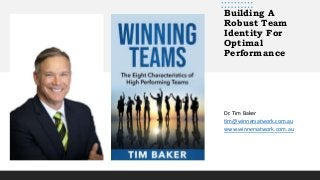
Characteristics of Team Identity
- 1. Building A Robust Team Identity For Optimal Performance Dr. Tim Baker tim@winnersatwork.com.au www.winnersatwork.com.au
- 2. WHAT IS TEAM IDENTITY? CHARACTERISTICS OF TEAM IDENTITY STRATEGIES
- 3. What is team identity? Team identity refers to the extent to which its members identify with the team. The stronger a team’s identity, the more its members connect with the team’s ethos. A compelling team identity results in its members readily associating with their team before the organization-at-large.
- 5. Buffering Buffering involves protecting the team’s resources from unwanted outside influence, distraction, and interference. Without buffering, other teams and individuals can easily cannibalize a team’s resources— whether they be human, administrative, or technical.
- 6. Examples of outside intrusion • A short-staffed team exerts pressure to redeploy an individual from another team to restore its capacity (human resources). • A project manager, working in a matrix organizational structure, coax a functional team member to attend several time-wasting project meetings, restricting the capacity of the functional team to get its work done (human resources). • Excessive administrative procedures that suffocate a team with red tape, under the guise of accountability or transparency (administrative resources). • A manager takes possession of what they believe is a ‘spare’ computer to suit their team’s purposes from a vacant workstation of another team (technical resources).
- 7. Bridging Bridging is the opposite of buffering. While buffering is an internal defence mechanism to shield the team, bridging involves reaching out to critical people and resources beyond the team. Having constructive working relationships with key stakeholders enables the team to achieve its goals. Bridging strengthen alliances within and outside the organization. Robust business relationships and partnerships galvanizes a team’s relevance.
- 8. Building • Building involves cultivating and sustaining a productive team culture. • Harnessing the benefits of a diversity, streamlining systems and processes, and promoting continuous learning are essential building blocks of a robust team culture. • Like buffering, building is internally focused. • But unlike buffering—where the energy is devoted to keeping at bay external forces that might interrupt and distract the work of the team—building activities are directed to attracting the energies and enterprise of members to a common purpose. • And in contract to bridging—where the effort is directed to importing critical resources and cooperation from the wider landscape—building entails utilizing team resources to accomplish the task-at-hand.
- 9. Strategies
- 10. The Three Key Elements of Productive Working Relationships in Teams Dr. Tim Baker https://www.eventbrite.com/e/413827197287 Fri, September 30, 2022 10 AM – 10:30 AM AEST
- 11. Normally $28 + postage. Now available for $15 + postage tim@winnersatwork.com.au
